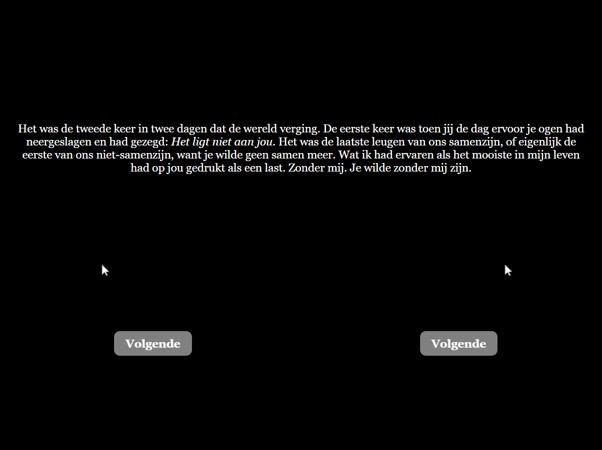In this blog, I would like to take you on my journey of writing my Master’s thesis on digital literature. It all started with choosing a subject out of a list containing over 100 thesis topics. As a New Media Design student, I specifically looked for a topic where I would be able to design something technological myself. The topic of digital literature turned out to be the perfect match!
Before coming up with a research question, I extensively researched existing literature to define any gaps in the field of digital literature. Here, I stumbled upon Bouchardon’s (2016) definition of digital literature as “all the creations that are based on a tension between literariness and digital media specificities”. I ended up studying the phenomenon of interpreting gestural interactions as figures. For instance, repetitively moving your computer mouse back and forth to reveal the layer underneath a piece of text could be interpreted figuratively as digging something up. In another context, however, the same gesture may be interpreted by the reader of a digital literary work as scratching an itch. This tension between the Digital (e.g. repetitively moving your cursor back and forth) and the Literary (e.g. digging something up, or scratching an itch) is what makes digital literature so incredibly interesting from a Human-Computer Interaction perspective. I set out to investigate how such interactions in computer-based literary works influence the readers’ narrative engagement, the perceived (dis)fluency of the work, and their interpretations.
To address this issue, I conducted an experiment with a digital literary work specifically made for this study. For the narrative, I took the first passage of the short story De vis in de fles by Thomas Olde Heuvelt. After interacting with one of four different versions of the story, participants answered questions on manipulation figure interpretation, perceived disfluency, and narrative engagement. Curious what the experiment looked like? You can interact with the digital literary work yourself via my website.
A total of over 150 participants took part in the experiment. After quantitatively analyzing the data in SPSS, findings suggested that non-conventional interactions stimulate the interpretation of manipulation figures, which supported the suggestion that manipulation figures arise when the interactor experiences an unexpected gap. In turn, the presence of manipulation figures also slightly increased the readers’ narrative engagement. Other hypotheses failed to provide a significant outcome, potentially due to constraints in design choices regarding the digital literary work.
From a practical perspective, the study aimed to investigate whether designing for manipulation figures makes digital narratives more engaging, which has the potential to create an interest in literature among the younger generation. Growing up in the digital era, it may be challenging to concentrate on reading printed works of literature that may not be as addictive as some digital applications are. Utilizing new media characteristics, digital literature could serve educational purposes in a more engaging way.
In this thesis, I got to apply several skills I had acquired over the last five years, as well as gain new knowledge and skills. I loved becoming an expert in the field of digital literature, and even though I will not continue to work in this field specifically, I will be able to apply what I’ve learned in other fields concerning interaction design. I hope to be seeing more and more digital literary works in the popular media as well as in education!

